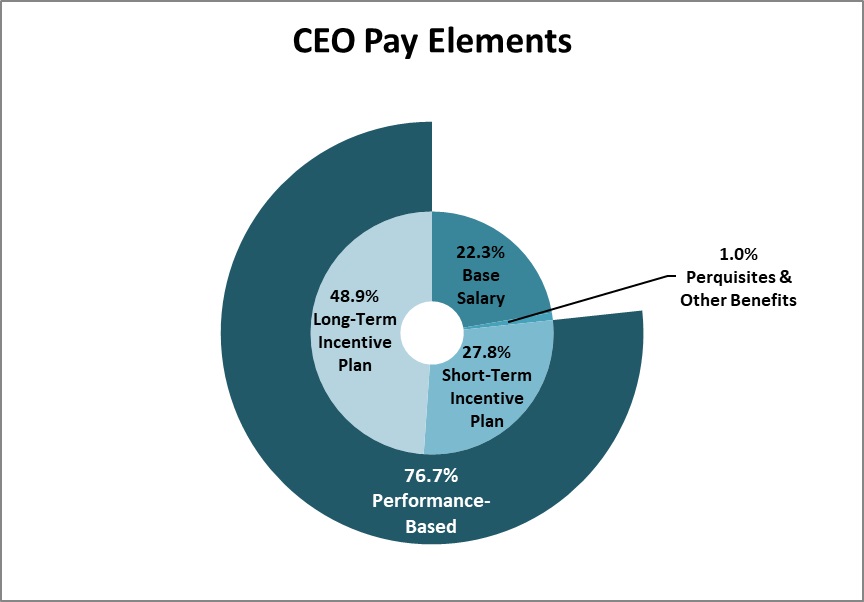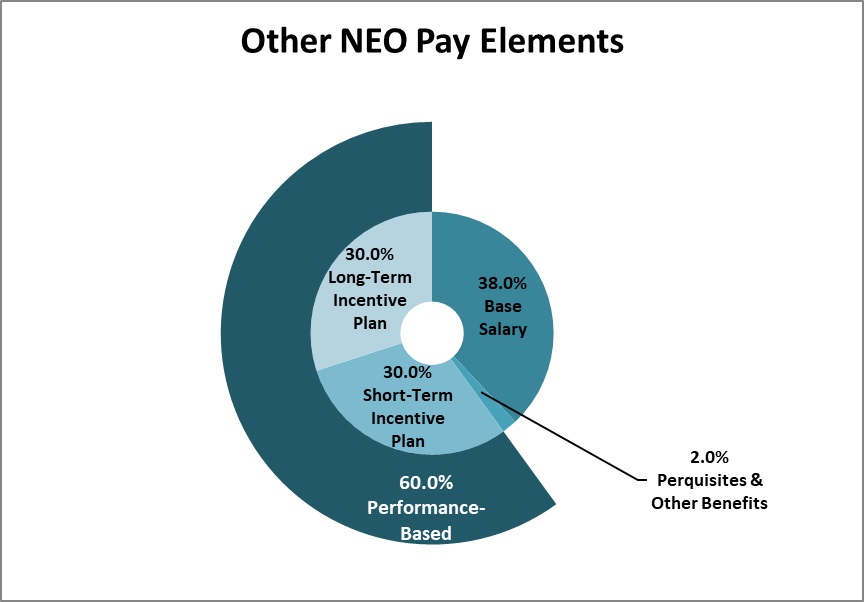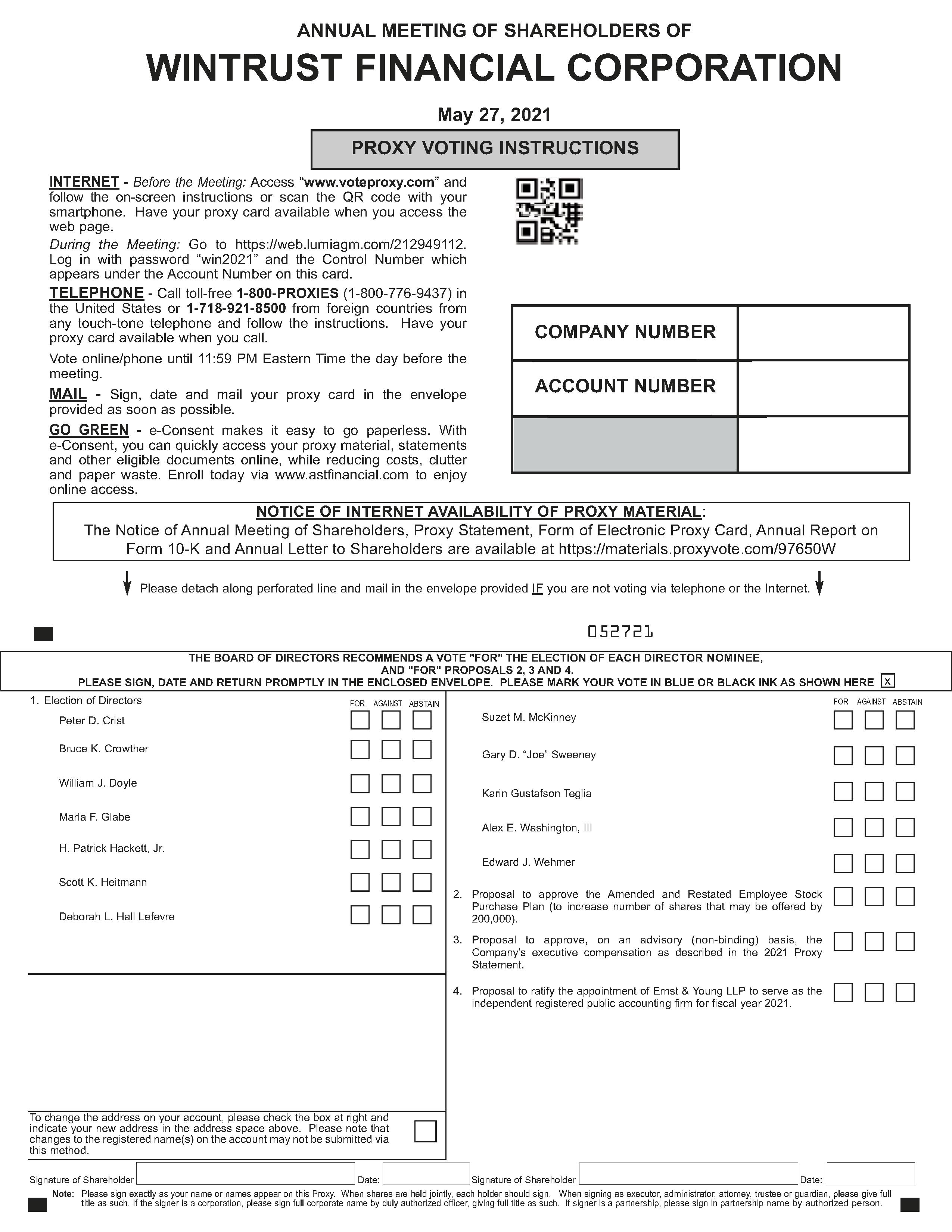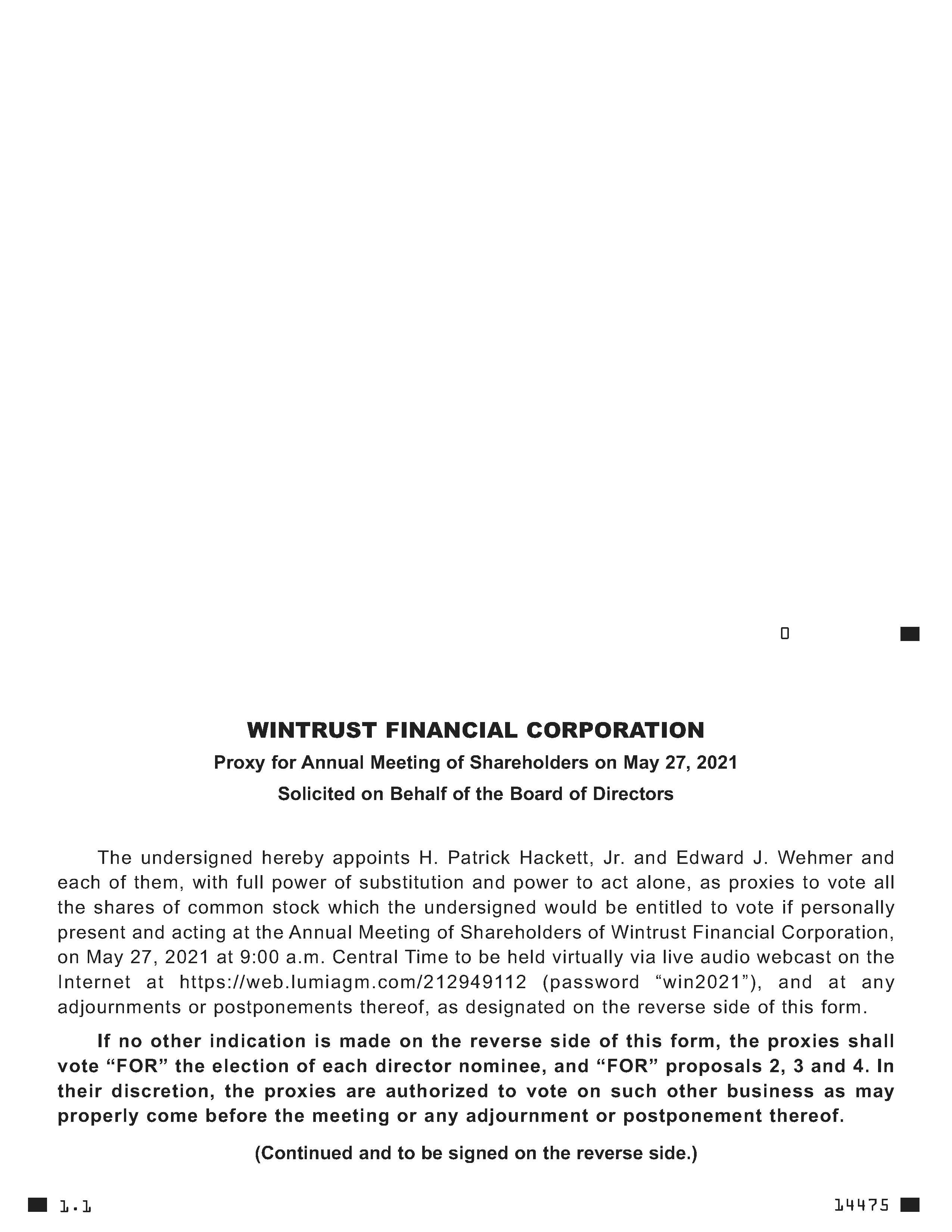ANNEX A
SECOND AMENDED AND RESTATED
ANNUAL MEETING OF SHAREHOLDERS OF WINTRUST FINANCIAL CORPORATION
EMPLOYEE STOCK PURCHASE PLAN
1.Purpose
May 25, 2023 9:00 AM Central Time GO GREEN e-Consent makes it easy to go paperless. With e-Consent, you can quickly access your proxy material, statements and other eligible documents online, while reducing costs, clutter and paper waste. Enroll today via www.astfinancial.com to enjoy online access. NOTICE OF INTERNET AVAILABILITY OF PROXY MATERIAL: The purposeNotice of the Wintrust Financial Corporation Employee Stock Purchase Plan isAnnual Meeting of Shareholders, Proxy Statement, Form of Electronic Proxy Card, Annual Report on Form 10-K and Annual Letter to encourage employee stock ownership, thereby enhancing employee commitment to Wintrust Financial Corporation (“Wintrust” or the “Corporation”)Shareholders are available at https://materials.proxyvote.com/97650W Please sign, date and providing an opportunity to sharemail your proxy card in the Corporation’s success. The Plan is amendedenvelope provided as soon as possible. + Please detach along perforated line and restated effective as ofmail in the date provided in Paragraph 21 hereof, as set forth herein.
2.Definitions
(a)“Bank” means any banking subsidiary of the Corporation designated by the Committee with respect to any offering.
(b)“Board” means the Boardenvelope provided.+ 052523 THEBOARD OF DIRECTORS RECOMMENDS A VOTE "FOR" THE ELECTION OF EACH DIRECTOR NOMINEE, AND "FOR" PROPOSALS 2 AND 4, AND "EVERY 1 YEAR" ON PROPOSAL 3. PLEASE SIGN, DATE AND RETURN PROMPTLY IN THE ENCLOSED ENVELOPE. PLEASE MARK YOUR VOTE IN BLUE OR BLACK INK AS SHOWN HERE • 0 1. Election of Directors ofFOR A.GA.tlST ABSTAN E li zabeth H . Co n nelly Timothy S. Crane Peter D. Crist Brian A. Kenney Deborah L. Hall Lefevre Suzet M. McKinney Gary D. "Joe" Sweeney FOR AGAtlST ABSTAN William J. Doyle Marla F. Gl abe H. Patrick Hackett, Jr. Scott K. Heitmann Karin Gustafson Teglia Alex E. Washington, Ill Edward J. Wehmer 2. Proposal lo approve, on an advisory (non-binding) basis, the Corporation.
(c)“Code” means the Internal Revenue Code of 1986, as amended.
(d)“Committee” means the Compensation Committee of the Board or any other committee designated by the Board to administer this Plan.
(e)“Common Stock” means Common Stock, no par value, of the Corporation.
(f)“Considered Compensation” meansCompany's executive compensation as defined bydescribed in the Committee2023 Proxy Statement. -----------------------------i Every Every Every 3 . P roposal to approve , on an advisory (non •bind ing) basis, theD D D D 1 year 2 years 3 years ABSTAN frequency of future shareholder advisory votes to approve the Company's executive compensation every one, two or three years. FOR AGAtJST ABSTAN 4. Propo sal to ratify the appointment of Ernst & Young LLP lo serve as the independent registered public accounting firm for fiscal year 2023. To change the address on your account, please check the box at right and indicate your new address in accordance with Section 423 of the Code and applicable regulations, including total compensation or base compensation for any pay period during or ataddress space above. Please note that changes to the beginning of, an Offering Period.
(g)“Fair Market Value” means the closing price as recorded by the NASDAQ National Marketregistered name(s) on the relevant valuation date or if no closing price has been recorded on such date, on the next preceding day on which such a closing price was recorded; provided, however, the Committee may specify some other definition of Fair Market Value.
(h)“Maximum Share Limit” means 1,325,000 shares of Common Stock.
(i)“Offering Period” means the term of any offering under the Plan as determined by the Committee which shall be at least three months in duration, but no more than 26 months in duration.
(j)“Participating Subsidiary” means any subsidiary or affiliate corporation of Wintrust designated by the Committee if on the first date of the Offering Period, Wintrust or a subsidiary of Wintrust, individually or collectively, owns 50% or more of the total combined voting power of all classes of stock of such corporation.
(k)“Plan” means this Wintrust Financial Corporation Second Amended and Restated Employee Stock Purchase Plan.
(l)“Purchase Date” means the last day of an Offering Period or any other day or days the Committee may prescribe under Paragraph 8(c)(ii).
(m)“Purchase Savings Account” means that portion of an aggregate account established with the Bank on behalf all participating employees that is attributable to a particular participating employee.
(n)“Wintrust” or “Corporation” means Wintrust Financial Corporation, an Illinois corporation.
The masculine pronoun wherever used herein is deemed to include the feminine, and the singular shall be deemed to include the plural whenever the context requires.
3.Administration
The Plan shall be administered by the Committee. The Committee, by majority action thereof (whether taken during a meeting or by written consent), is authorized to interpret the Plan, to prescribe, amend, and rescind rules and regulations relating to the Plan, to provide for conditions and assurances deemed necessary or advisable to protect the interests of the Corporation, and to make all other determinations necessary or advisable for the administration of the Plan. To the extent deemed necessary or advisable for purposes of Rule 16b-3 under the Securities Exchange Act of 1934, as amended, any member of the Committee who is not a “non-employee director” under such Rule may abstain or recuse himself from any action of the Committee, in which case a majority action of the remaining members shall constitute a majority action of the Committee.
The Committee may employ such agents, attorneys, accountants or any other persons and delegate to them such powers, rights and duties, as the Committee may consider necessary to properly carry out the administration of the Plan. The interpretation and construction by the Committee of any provisions of the Plan and the terms and conditions of an offering including employee participation thereunder and any determination by the Committee pursuant to any provision of the Plan shall be final and conclusive.
4.Offerings Under the Plan
The Committee shall determine whether Wintrust shall make an offering to all of the then eligible employees, provided, however, that it shall be under no obligation to do so. In the event of an offering under the Plan, an offering prospectus, or such other document as may then be required under applicable law, shall be prepared which outlines the specific terms and conditions of such offering.
5.Eligibility
All employees of Wintrust or of any Participating Subsidiary shall be eligible to participate in an offering under the Plan except that the Committee may, with respect to any offering, exclude from eligibility (i) any employee who normally works less than 20 (or such lesser number determined by the Committee) hours a week, (ii) any employee who normally works less than five (or such lesser number determined by the Committee) months a year, (iii) any employee who, on the first date of the applicable Offering Period, has not been employed by Wintrust or a Participating Subsidiary for at least 24 (or such lesser number determined by the Committee) months immediately prior thereto and (iv) any employee who is a highly compensated employee (as defined in Section 414(q) of the Code); provided, however, that the Committee may exclude employees who have completed a shorter period of service or whose customary employment is for fewer months in a calendar year than is specified in (i), (ii) or (iii), provided that the exclusion is applied in an identical manner to all employees who are granted options under the Plan or offering. In the case of employees of a Participating Subsidiary who become employed as a result of the acquisition by Wintrust or a Participating Subsidiary of all or part of the assets or stock of such employees’ previous employer and the previous employer does not become a Participating Subsidiary, the Committee may establish a separate “offering” under this Plan in accordance with Treasury Regulation §1.423-2(a) and each employee’s employment date will be considered to be the date he was employed by his previous employer solely for the purpose of applying provision (iii) above, unless otherwise determined by the Committee.
6.Stock
The shares of Common Stock offered hereunder may be treasury shares, authorized and unissued shares, shares purchased in the open market (on an exchange or in negotiated transactions) or any combination thereof. Subject to adjustment in accordance with the provisions of Paragraph 8(f), the total number of shares of Common Stock which may be offered shall not exceed the Maximum Share Limit. If at any time participating employees elect to purchase more than the Maximum Share Limit, then the number of shares of Common Stock which may be purchased by each participating employee shall be reduced pro rata.
In the event that an employee’s participation under the Plan for any reason ends or is terminated and the shares which are subject to option are not purchased, such unpurchased shares of Common Stock shall again be available for offering under the Plan.
7.Number of Shares Which an Employee May Purchase
Wintrust may grant to each participating employee, on a nondiscriminatory basis, an option to purchase such number of shares of Common Stock with respect to a given offering as shall have an aggregate purchase price not in excess of $25,000.
Alternatively, Wintrust may grant to each participating employee, on a nondiscriminatory basis, an option to purchase a fixed or maximum number of shares of Common Stock determined on the first date of the Offering Period, provided that the aggregate purchase price must comply with limitations set forth in the preceding sentence.
Notwithstanding the foregoing provisions of this Plan, no employee may participate in an offering under the Plan (i) if such participation would permit the employee to purchase shares of Common Stock under all the employee stock purchase plans of Wintrust and its Participating Subsidiaries qualified under Section 423 of the Code at a rate which exceeds $25,000 in fair market value of such shares for each calendar year during which an option granted to the employee under the Plan is outstanding (determined based on the fair market value of the stock at the time the option was granted), or (ii) if such employee, immediately after his participation commences, owns stock possessing five percent or more of the total combined voting power or value of all classes of stock of Wintrust or any Participating Subsidiary. For such purpose, the rules of Section 424(d) of the Code, as amended, shall apply in determining the stock ownership of an employee, and stock which the employee may purchase pursuant to his participation in the Plan and under all other plans or options of Wintrust or any Participating Subsidiary shall be treated as stock owned by the employee.
8.Terms and Conditions of Participation in an Offering Under the Plan
An eligible employee’s participation in an offering under this Plan shall comply with and be subject to the following:
(a)Purchase Price. The purchase price per share of Common Stock shall be determined by the Committee at the outset of the offering; provided, however, the purchase price may not be lower thansubmitted via this method. D D D • • Signature of Shareholder - - - - - - - - - - - - - Date: - - - - Signature of Shareholder - - - - - - - - - - - - - Date: [ J Note: Please sign exactl y as your name or names appear on this Proxy. When shares are held jointty, each holder shoold sign. When signing as executor, administrator,at1omey, trus tee or guardian , please give fuH title as such If the lesser of 85 percent of the Fair Market Value of the shares of Common Stock on the first date of the Offering Period or 85 percent of the Fair Market Value of the shares of Common Stock on the Purchase Date.signer
(b)Purchase Savings Account. A participating employee shall authorize the withholding from his compensation, throughout the Offering Period, of a dollar amount or percent of salary per pay period, the maximum of which is subject to the limits of Paragraph 7 or other lesser limitations set by the Committee. Withheld amounts will be credited to the employee’s Purchase Savings Account. Subject to the applicable limitations contained in Paragraph 7 hereof, the employee shall not be entitled to make any other deposits to his Purchase Savings Account, unless the Committee so determines, and then, only to the extent permitted by the Committee and in accordance with Treasury Regulation §1.423-2. No interest shall accrue at any time for any amount credited to a Purchase Savings Account.
After the employee’s withholding election has been received and approved by Wintrust, the employee shall not be entitled to change such election during the Offering Period unless, subject to the applicable limitations contained in Paragraph 7 hereof, the Committee so determines, and then, only to the extent permitted by the Committee and in accordance with Treasury Regulation §1.423-2.
Notwithstanding the foregoing, the employee may withdraw funds accumulated in his Purchase Savings Account at any time, except as the Committee may otherwise provide. The Bank reserves the right, as a condition of any Purchase Savings Account, to demand and receive thirty days’ notice, in writing, as a condition of the withdrawal of any sum or sums whenever such requirement may be deemed advisable by the Bank, in its discretion.
(c)Purchase of Shares.
(i) Subject to earlier purchase pursuant to Paragraphs 8(c)(ii), 8(e) and 8(g) hereof, each employee shall specify on or before the Purchase Date whether he desires to purchase all, a portion or none of the shares of Common Stock which he is entitled to purchase as a result of his participation in the offering. Except as set forth in the next paragraph, if the employee fails to deliver the notification referred to in this paragraph, such failure shall be
deemed an election by the employee to exercise his right to purchase on the Purchase Date all of the shares of Common Stock which he is entitled to purchase.
On the Purchase Date, the Bank shall cause the funds then credited to the employee’s Purchase Savings Account to be applied to the purchase price of the shares of Common Stock the employee elected to purchase. Any funds remaining in the Purchase Savings Account after such purchase will be paid to the employee and the Purchase Savings Account will be closed; provided, however, any payroll deductions accumulated in an employee’s Purchase Savings Account which are not sufficient to purchase a full share of Common Stock shall be retained in the Purchase Savings Account for the next subsequent Offering Period, subject to earlier withdrawal by the employee as provided in this Section 8.
(ii) The Committee may determine that Wintrust shall make an offering which shall have more than one Purchase Date and, in such case, the Committee shall establish the dates (each a “Purchase Date”) on which purchases of shares of Common Stock can or will be made by participating employees during an Offering Period. The Committee shall set the terms, conditions and other procedures necessary for the proper administration of such Offering.
(d)Termination of Participation by Employee. An employee who participates in an offering may at any time on or before the expiration of the Offering Period terminate participation by written notice of such termination on a form prescribed by the Committee and delivered to Wintrust. As soon as practicable thereafter, all funds then credited to his Purchase Savings Account will be paid to the employee and his Purchase Savings Account will be closed.
(e)Termination of Employment. In the event that a participating employee’s employment with Wintrust and/or a Participating Subsidiary terminates during the term of an Offering Period, his participation under the Plan shall terminate immediately and within a reasonable time thereafter all funds then credited to his Purchase Savings Account will be paid to the employee.
(f)Recapitalization. The aggregate number of shares of Common Stock which may be offered under the Plan, the number of shares of Common Stock which each employee is entitled to purchase as a result of his participation in an offering and the purchase price per share for each such offering shall all be proportionately adjusted for any increase or decrease in the number of issued shares of Common Stock resulting from a subdivision or consolidation of shares or other capital adjustment, or the payment of a stock dividend, or other increase or decrease in such shares of Common Stock, effected without receipt of consideration by Wintrust; provided, however, that any fractional shares of Common Stock resulting from any such adjustment shall be eliminated.
Subject to any required action by stockholders, if Wintrust shall be the surviving or resulting corporation in any merger or consolidation, excluding for this purpose a merger or consolidation which, or the approval of which by the stockholders of Wintrust, constitutes a Change of Control (and, thus, the consequences of which are otherwise provided for in Paragraph 8(g) hereof), any employee’s rights to purchase stock pursuant to participation in an offering hereunder shall pertain to and apply to the shares of stock to which a holder of the number of shares of Common Stock subject to such rights would have been entitled; but a dissolution or liquidation of Wintrust or a merger or consolidation in which Wintrust is not the surviving or resulting corporation, excluding for this purpose a merger or consolidation which, or the approval of which by the stockholders of Wintrust, constitutes a Change of Control (and, thus, the consequences of which are otherwise provided for in Paragraph 8(g) hereof), shall cause all participation in any offering made under the Plan which is then in effect to terminate, except that the surviving or resulting corporation may, in its absolute and uncontrolled discretion, tender an offer to purchase its shares on terms and conditions both as to the number of shares and otherwise, which will substantially preserve the rights and benefits of employees participating in an offering then in effect under the Plan.
In the event of a change in Common Stock which is limited to a change in the designation thereof to “Capital Stock” or other similar designation, or to a change in par value thereof, or from par value to no par value, without increase in the number of issued shares, the shares resulting from any such change shall be deemed to be Common Stock within the meaning of the Plan.
(g)Change of Control. Anything in the Plan to the contrary notwithstanding, the date on which a “Change of Control” (as defined below) occurs shall be considered to be a Purchase Date with respect to all Offering Periods under the Plan and each employee who is a participant in the Plan shall thereupon have the right to purchase all or fewer than all of the shares of Common Stock which he is entitled to purchasecorporation, please sign full corporate name by duly authorizedofficer, giving tu• title as a result of his participation in the offering with the funds then credited to his Purchase Savings Account or to be promptly paid in cash all funds credited to his Purchase Savings Account. For this purpose, a “Change of Control” shall mean:
(i) The acquisition, other than from the Corporation, by any individual, entity or group (within the meaning of Section 13(d)(3) or 14(d)(2) of the Securities Exchange Act of 1934, as amended (the “Exchange Act”)) of beneficial ownership (within the meaning of Rule 13d-3 promulgated under the Exchange Act) of 50% or more of either the then outstanding shares of Common Stock of the Corporation or the combined voting power of the then outstanding voting securities of the Corporation entitled to vote generally in the election of directors, but excluding, for this purpose, any such acquisition by the Corporation or any of its subsidiaries, or any employee benefit plan (or related trust) of the Corporation or its subsidiaries, or any corporation with respect to which, following such acquisition, more than 50% of, respectively, the then outstanding shares of common stock of such corporation and the combined voting power of the then outstanding voting securities of such corporation entitled to vote generally in the election of all or substantially all directors is then beneficially owned, directly or indirectly, by the individuals and entities who were the beneficial owners, respectively, of the Common Stock and voting securities of the Corporation immediately prior to such acquisition in substantially the same proportion as their ownership, immediately prior to such acquisition, of the then outstanding shares of Common Stock of the Corporation or the combined voting power of the then outstanding voting securities of the Corporation entitled to vote generally in the election of directors, as the case may be; or
(ii) Individuals who, as of the date hereof, constitute the Board (as of the date hereof the “Incumbent Board”) cease for any reason to constitute at least a majority of the Board, provided that any individual becoming a director subsequent to the date hereof whose election, or nomination for election by the Corporation’s shareholders, was approved by a vote of at least a majority of the directors then comprising the Incumbent Board shall be considered as though such individual were a member of the Incumbent Board, but excluding, for this purpose, any such individual whose initial assumption of office is in connection with an actual or threatened election contest relating to the election of the directors of the Corporation (as such terms are used in Rule 14a-11 of Regulation 14A promulgated under the Exchange Act); or
(iii) The consummation of a reorganization, merger or consolidation of the Corporation, in each case, with respect to which all or substantially all of the individuals and entities who were the respective beneficial owners of the Common Stock and voting securities of the Corporation immediately prior to such reorganization, merger or consolidation do not, following such reorganization, merger or consolidation, beneficially own, directly or indirectly, more than 50% of, respectively, the then outstanding shares of Common Stock and the combined voting power of the then outstanding voting securities entitled to vote generally in the election of directors, as the case may be, of the corporation resulting from such reorganization, merger or consolidation, or a complete liquidation or dissolution of the Corporation or of the sale or other disposition of all or substantially all of the assets of the Corporation.
(h)Assignability. No Purchase Savings Account, or option to purchase shares of, Common Stock hereunder shall be assignable, by pledge or otherwise, or transferable except by will or by the laws of descent and distribution; and no right of any employee to purchase stock pursuant to an offering made hereunder shall be subject to any obligation or liability of such employee or have a lien imposed upon it. During the lifetime of an employee, the shares of Common Stock which he is entitled to purchase under the Plan may be purchased only by the employee.
(i)Restrictions on Transferability.such. If at the time of the purchase of shares of Common Stock under the Plan, in the opinion of counsel for Wintrust, it is necessary or desirable, in order to comply with any applicable laws or regulations relating to the purchase or sale of securities, that the employee purchasing such shares shall agree not to purchase or dispose of such shares otherwise than in compliance with the Securities Act of 1933 or the Exchange Act, as amended, and the rules and regulations promulgated thereunder, the employee will, upon the request of Wintrust, execute and deliver to Wintrust an agreement to such effect.
(j)Rights as Stockholder. An employee whosigner is a participant hereunder shall have no rights as a stockholder with respect to shares of Common Stock which he is entitled to purchase under the Plan until the date of the issuance of the shares of Common Stock to the employee.partnership, please sign in partnership name by authorized person.

![[MISSING IMAGE: sg_kathleenmboege-bw.jpg]](/files/DEF 14A/0001104659-23-042688/sg_kathleenmboege-bw.jpg)
![[MISSING IMAGE: pc_ceoneo-4c.jpg]](/files/DEF 14A/0001104659-23-042688/pc_ceoneo-4c.jpg)


![[MISSING IMAGE: bc_adjustedeps-4c.jpg]](/files/DEF 14A/0001104659-23-042688/bc_adjustedeps-4c.jpg)
![[MISSING IMAGE: bc_netincome-4c.jpg]](/files/DEF 14A/0001104659-23-042688/bc_netincome-4c.jpg)
![[MISSING IMAGE: bc_tsr-4c.jpg]](/files/DEF 14A/0001104659-23-042688/bc_tsr-4c.jpg)
![[MISSING IMAGE: px_page1proxy2-bw.jpg]](/files/DEF 14A/0001104659-23-042688/px_page1proxy2-bw.jpg)
![[MISSING IMAGE: px_page2proxy2-bw.jpg]](/files/DEF 14A/0001104659-23-042688/px_page2proxy2-bw.jpg)

